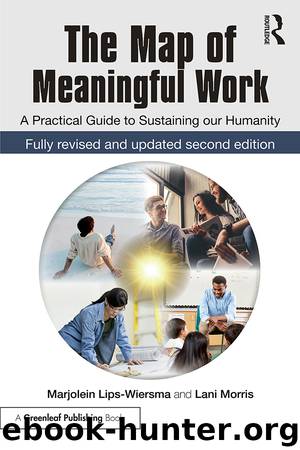The Map of Meaningful Work (2e) by Lips-Wiersma Marjolein; Morris Lani; & Lani Morris

Author:Lips-Wiersma, Marjolein; Morris, Lani; & Lani Morris
Language: eng
Format: epub
Publisher: Routledge
6
Taking responsibility between Inspiration and Reality in contemporary organisations
Ideally, organisations are driven by their purpose, and much energy is put into purpose and mission statements. Yet, so often the mission is left sitting on a sign on the wall, or a computer screen. It does not become a driver for the people in the organisation, the lever for change, or the standard against which actions are evaluated. What happens when there is a gap between the vision and the lived experience of the people working in the organisation?
Figure 6.1 shows that between the purpose and the systems designed to fulfil this purpose, is the human experience. Here we can explore how the systems so often frustrate people’s ability to engage with and express the vision.
In this chapter we show how the Map of Meaning enables people to clearly express their experience of which systems frustrate, and which systems support, both the purpose and their experience of meaningful work. Doing this with both managers and staff in the room helps to explain why staff are not engaged, and also to create joint solutions.
At the centre of this diagram is the particular organisation’s purpose or reason for existing (usually stated on their website). It is increasingly recognised that the purpose of the company itself needs to rise above the immediate reality of the organisation. Companies are therefore increasingly defining ‘purpose beyond profit’. The reason for this is simple: it meets the human need for inspiration, driving sustainable success and long-term profit. Together with principles and values, purpose is what a great company stands for and would stand by even if adhering to them resulted in a competitive disadvantage, missed opportunity or increased costs (Jackson and Nelson 2004: 299). We will come back to purpose and how it can inspire all members of the organisation later in this chapter.
Figure 6.1 Outside-in versus inside-out organising (adapted from Wouter Hart, Verdraaide Organisaties 2012)
Download
This site does not store any files on its server. We only index and link to content provided by other sites. Please contact the content providers to delete copyright contents if any and email us, we'll remove relevant links or contents immediately.
| Ethics | Etiquette |
| Fashion & Image | Health & Stress |
| Motivation & Self-Improvement | Work Life Balance |
| Workplace Culture |
Tools of Titans by Timothy Ferriss(8215)
Change Your Questions, Change Your Life by Marilee Adams(7634)
Deep Work by Cal Newport(6877)
Man-made Catastrophes and Risk Information Concealment by Dmitry Chernov & Didier Sornette(5921)
Playing to Win_ How Strategy Really Works by A.G. Lafley & Roger L. Martin(5914)
Digital Minimalism by Cal Newport;(5661)
Big Magic: Creative Living Beyond Fear by Elizabeth Gilbert(5610)
The Slight Edge by Jeff Olson(5346)
Ego Is the Enemy by Ryan Holiday(5292)
The Motivation Myth by Jeff Haden(5155)
Stone's Rules by Roger Stone(5026)
The Laws of Human Nature by Robert Greene(4996)
Tuesdays with Morrie by Mitch Albom(4686)
Eat That Frog! by Brian Tracy(4432)
Rising Strong by Brene Brown(4377)
Skin in the Game by Nassim Nicholas Taleb(4161)
Bullshit Jobs by David Graeber(4094)
The Money Culture by Michael Lewis(4075)
Skin in the Game: Hidden Asymmetries in Daily Life by Nassim Nicholas Taleb(3929)
